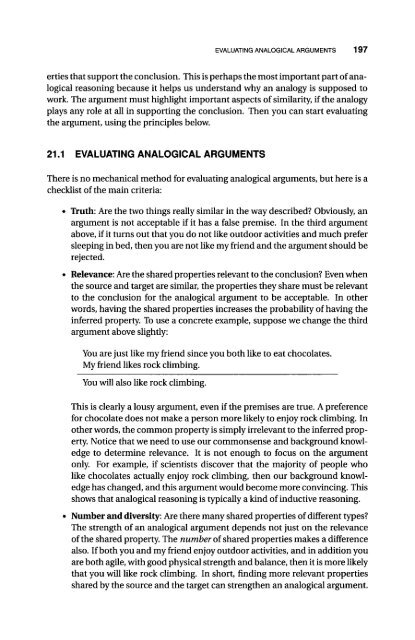An Introduction to Critical Thinking and Creativity - always yours
An Introduction to Critical Thinking and Creativity - always yours
An Introduction to Critical Thinking and Creativity - always yours
You also want an ePaper? Increase the reach of your titles
YUMPU automatically turns print PDFs into web optimized ePapers that Google loves.
EVALUATING ANALOGICAL ARGUMENTS 197<br />
erties that support the conclusion. This is perhaps the most important part of analogical<br />
reasoning because it helps us underst<strong>and</strong> why an analogy is supposed <strong>to</strong><br />
work. The argument must highlight important aspects of similarity, if the analogy<br />
plays any role at all in supporting the conclusion. Then you can start evaluating<br />
the argument, using the principles below.<br />
21.1 EVALUATING ANALOGICAL ARGUMENTS<br />
There is no mechanical method for evaluating analogical arguments, but here is a<br />
checklist of the main criteria:<br />
• Truth: Are the two things really similar in the way described? Obviously, an<br />
argument is not acceptable if it has a false premise. In the third argument<br />
above, if it turns out that you do not like outdoor activities <strong>and</strong> much prefer<br />
sleeping in bed, then you are not like my friend <strong>and</strong> the argument should be<br />
rejected.<br />
• Relevance: Are the shared properties relevant <strong>to</strong> the conclusion? Even when<br />
the source <strong>and</strong> target are similar, the properties they share must be relevant<br />
<strong>to</strong> the conclusion for the analogical argument <strong>to</strong> be acceptable. In other<br />
words, having the shared properties increases the probability of having the<br />
inferred property. To use a concrete example, suppose we change the third<br />
argument above slightly:<br />
You are just like my friend since you both like <strong>to</strong> eat chocolates.<br />
My friend likes rock climbing.<br />
You will also like rock climbing.<br />
This is clearly a lousy argument, even if the premises are true. A preference<br />
for chocolate does not make a person more likely <strong>to</strong> enjoy rock climbing. In<br />
other words, the common property is simply irrelevant <strong>to</strong> the inferred property.<br />
Notice that we need <strong>to</strong> use our commonsense <strong>and</strong> background knowledge<br />
<strong>to</strong> determine relevance. It is not enough <strong>to</strong> focus on the argument<br />
only. For example, if scientists discover that the majority of people who<br />
like chocolates actually enjoy rock climbing, then our background knowledge<br />
has changed, <strong>and</strong> this argument would become more convincing. This<br />
shows that analogical reasoning is typically a kind of inductive reasoning.<br />
• Number <strong>and</strong> diversity: Are there many shared properties of different types?<br />
The strength of an analogical argument depends not just on the relevance<br />
of the shared property. The number of shared properties makes a difference<br />
also. If both you <strong>and</strong> my friend enjoy outdoor activities, <strong>and</strong> in addition you<br />
are both agile, with good physical strength <strong>and</strong> balance, then it is more likely<br />
that you will like rock climbing. In short, finding more relevant properties<br />
shared by the source <strong>and</strong> the target can strengthen an analogical argument.
















